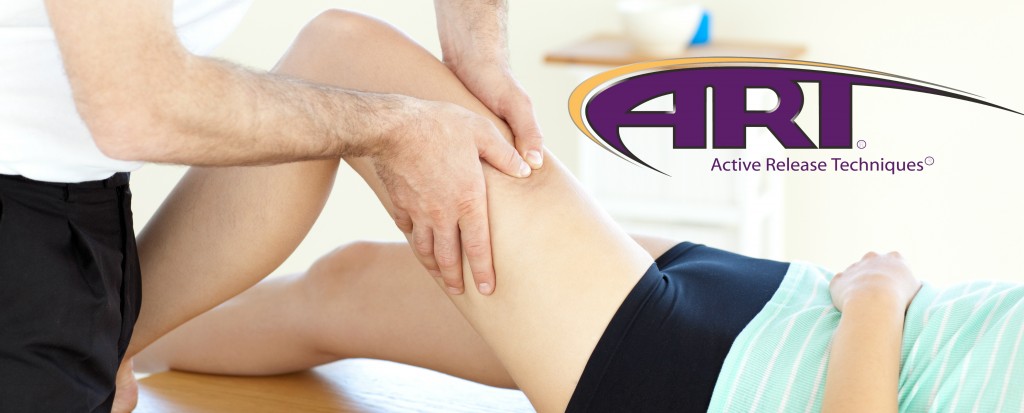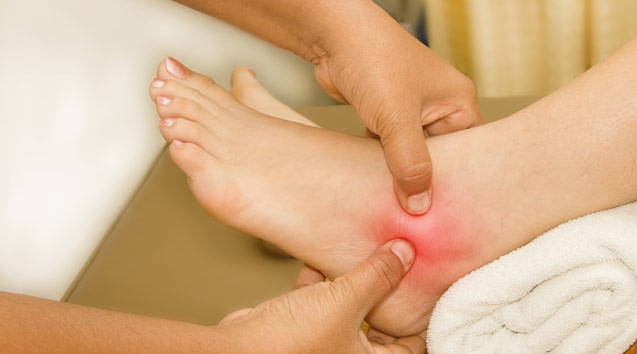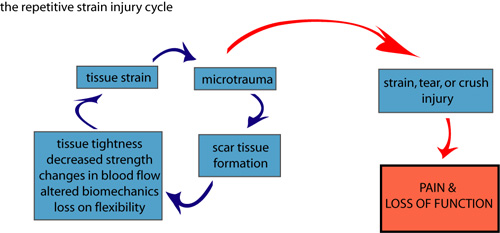Resolving Foot and Ankle Injuries with Active Release Techniques (ART)
The ankle is a critical area for athletes as it forms the primary connection between the body and the ground. As a result, a tremendous amount of force and pressure passes through the foot and ankle on a regular basis. Athletic activities involving running, jumping, kicking, swinging, and rapid changes in direction require a considerable amount of strength and flexibility from the ankle and its surrounding muscles. Due to the high levels of force and the mechanical stress placed on the foot and ankle, this region is frequently the site of injury in a wide variety of sporting activities. Unfortunately, when these foot and ankle injuries occur they not only prevent optimal performance, but they often progress to the point of preventing competition and training all together. To make matters worse, many of the most common foot and ankle conditions are slow to respond to traditional types of treatment and can result in months of frustration for the athlete. Fortunately, a new treatment technique known as Active Release Techniques® (ART® ) is proving to be a very successful method to combat many common foot and ankle problems, and is helping to get athletes back in the game quickly and effectively. But before we talk about why ART® works so effectively we first need to understand how the ankle becomes injured in the first place.
How Do Foot and Ankle Injuries Develop?
The ankle joint forms the connection between the 2 bones of the lower leg – the Tibia and Fibula – and the Talus bone on top of the foot. Proper strength and mobility of this area is critical in many athletic activities as the ankle serves as both a pivot point, and as an energy transfer station between the body and the ground. For example, with running, as the foot pushes off the ground the force that is generated from the muscles in the leg is transferred to the ground through the foot and ankle causing the body to be propelled forward. For optimal performance and to prevent injury, the foot and ankle must have the capacity to effectively generate and transfer forces not only in the forward direction, as we see with running, but also in the side-to-side and rotational directions, which is important for sports involving swinging (baseball, golf) or cutting movements (soccer, football, basketball). In order to stabilize the foot and ankle and to prevent excessive strain to the area, the ankle relies on a complex system of muscles and tendons that surround the ankle in all directions. These muscles, which begin high in the lower leg just below the knee, have long tendons that travel down across the ankle and attach into the heel and the foot. It is these muscles that must contract to protect and stabilize the foot and ankle. When there is adequate strength, flexibility, and balance of these muscles the chances of injury is greatly reduced; but, because of the demand placed on foot and ankle with many sporting activities, problems commonly develop in these critical muscles leading to a variety of athletic injuries.
Understanding the Injury Process?
Athletic activities require a considerable amount of strength, flexibility, and coordination from the foot and ankle muscles. This increased demand can place a tremendous workload on these muscles as they are required to generate an incredible amount of force to protect and stabilize the ankle region. To make matters worse, most sports demand that the same running, cutting, kicking, or swinging motions are repeated over and over again. This combination of repetitive motion and high muscular demand can cause problems to develop in the foot and ankle as the muscles often cannot keep up with the workload. Over time the muscles of the lower leg can become strained and develop small scale injury known as micro-trauma. Initially, this micro-trauma is not painful, but may be perceived as a mild ache or tightness in the foot, ankle, or lower leg. Although only small, this damage still needs to be repaired. The body responds to tissue injury in a very predictable way – by laying down new tissue to repair the damaged tissue. With micro-trauma the body repairs the strained tissue by laying down small amounts of scar tissue in and around the injured area. The scar tissue itself is not a problem – in fact it is a normal and necessary part of healing. The problem occurs when the ankle is subjected to the same high workload due to the continued, repetitive, high force athletic movements. This in turn causes the same muscles to become strained and subsequently repaired over and over again. Over time this scar tissue will build-up and accumulate into what are called adhesions. As these adhesions form they start to affect the normal health and function of the muscles. In fact, they will often lead to pain, tightness, stiffness, restricted joint motion, and diminished blood flow.
As scar tissue adhesions accumulate in and around the muscles of the foot, ankle, and lower leg it places more and more strain on the area as the muscles and associated tendons must now stretch and contract against these adhesions in an attempt to move and stabilize the ankle. This places even further strain on the muscles, which in turn leads to even more micro-trauma. Essentially, a repetitive injury cycle is established causing continued adhesion formation and progressive ankle dysfunction. As the cycle progresses, the ability of the muscles to contract properly is affected and the protection and stability of the ankle becomes compromised. At this point it is not uncommon for the muscles to give way and a more severe and debilitating pain to occur – such as a muscle injury or ankle sprain. In fact, many athletes come into our office explaining how they have hurt their foot or ankle during a routine task that they have done thousands of times before. When further questioned these athletes almost always describe some mild pain or tightness that has been building over time. As you can see from the explanation of the repetitive injury cycle, these types of injuries build-up over time and the more acute injury is often just the “straw that broke the camels back”.
How Can These Foot and Ankle Injuries Be Fixed?
The Traditional Approach…
In an attempt to relieve foot and ankle pain, a variety of treatment methods are used, either on their own, or in combination with other methods. Some of the more common approaches include anti-inflammatory medications, rest, ice, ultrasound (US), muscle stimulation (E-Stim), steroid injections, stretching, exercise, and when all else fails, surgery. Unfortunately, most of these traditional techniques generally require a long period of time before they provide any significant relief, and in many cases provide only temporary relief from symptoms instead of fixing the underlying cause of the problem. This can be a huge problem as athletes often want, and need to get back to training and competition as soon as possible.
The main reason that these approaches are often ineffective is that they fail to address the underlying scar tissue adhesions that develop within the muscles and surrounding soft tissues. It is these adhesions that are binding the tissues together, restricting normal movements, and interfering with the normal flexibility and contraction of the muscles in the ankle area. Passive approaches such as medications, rest, ice, and steroid injections all focus on symptomatic relief and do nothing to address the muscle restrictions and dysfunction. More active approaches such as stretching and exercises are often needed for full rehabilitation of the condition and to restore full strength and function of the muscles; however, they themselves do not treat the underlying adhesions. In fact, without first addressing the scar tissue adhesions, stretches and exercises are often less effective and much slower to produce relief or recovery from the foot or ankle condition.
Active Release Techniques® Our Approach: ART® – A Better Solution
ART stands for Active Release Technique. It is a new and highly successful hands-on treatment method to address problems in the soft tissues of the body, including the muscles, ligaments, fascia, and nerves. ART* treatment is highly successful in dealing with paddling related injuries because it is specifically designed to locate and treat scar tissue adhesions that accumulate in the muscles and surrounding soft tissues. By locating and treating the soft-tissue adhesions with ART*, it allows the practitioner to, 1) break-up restrictive adhesions, 2) reinstate normal tissue flexibility and movement, and 3) more completely restore flexibility, balance, and stability to the injured area and to the entire kinetic chain.

You can think of an ART* treatment as a type of active massage. The practitioner will first shorten the muscle, tendon, or ligament, and then apply a very specific pressure with their hands as you actively stretch and lengthen the tissues. As the tissue lengthens the practitioner is able to assess the texture and tension of the muscle to determine if the tissue is healthy or contains scar tissue that needs further treatment. When scar tissue adhesions are felt the amount and direction of tension can be modified to treat the problematic area. In this sense, each treatment is also an assessment of the health of the area as we are able to feel specifically where the problem is occurring.
An additional benefit of ART is it allows us to further assess and correct problems not only at the site of pain itself, but also in other areas of the kinetic chain, which are associated with movement compensations and are often contributing factors to the problem. This ensures that all the soft tissues that have become dysfunctional and are contributing to the specific injury are addressed, even if they have not yet all developed pain. One of the best things about ART is how fast it can get results. In our experience, the majority of paddling related injuries respond very well to ART* treatment, especially when combined with the appropriate home stretching and strengthening exercises. Although each case is unique and there are several factors that will determine the length of time required to fully resolve each condition, we usually find a significant improvement can be gained in just 4 – 6 treatments. These results are the main reason that many elite athletes and professional sports teams have ART practitioners on staff, and why ART is an integral part of the Iron man triathlon series. To book an appointment to see if ART will be able to help with your paddling related injury, simply call our office at 613.237.3306 or fax 613.237.3100




